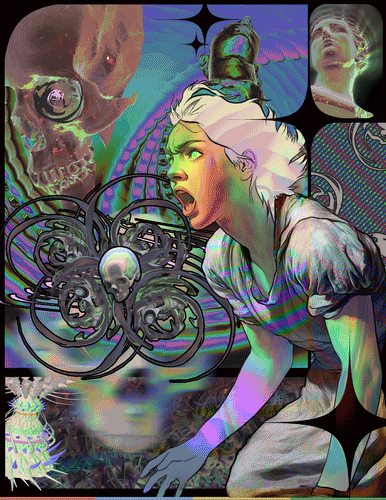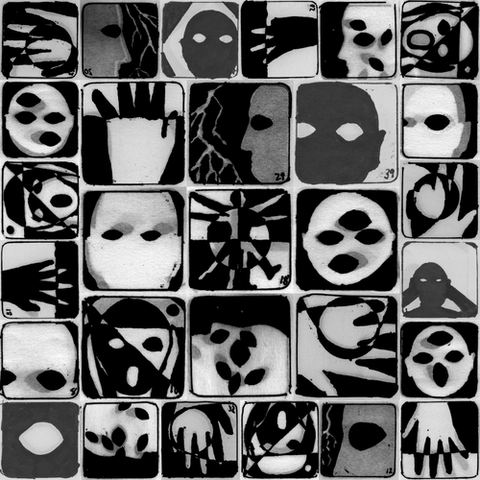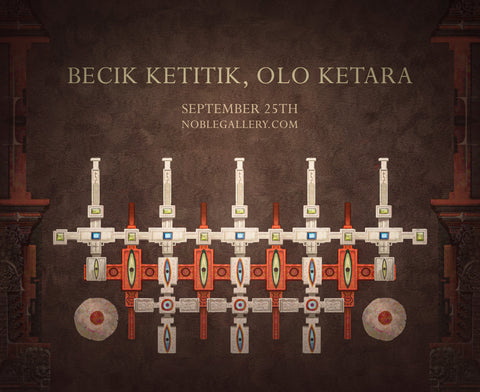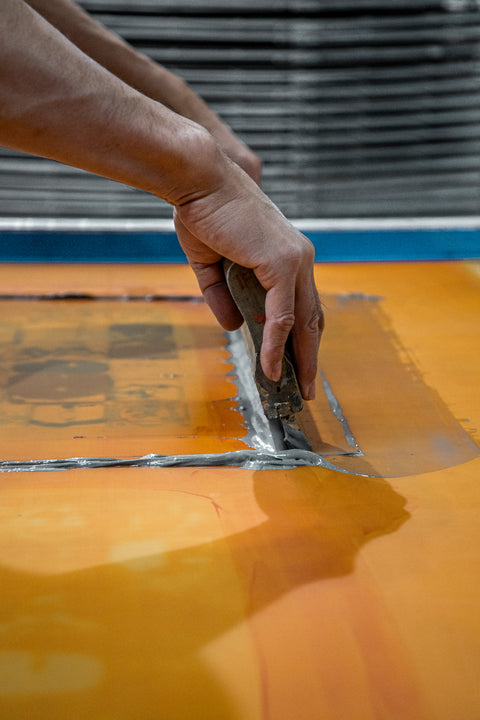
neurocolor is a Mexican artist known for his vivid, multi-layered works that blend digital experimentation with traditional techniques. A fascination with internet culture, glitch aesthetics, and classical iconography defines his style, creating pieces that feel simultaneously modern and timeless.
Trained in traditional art, neurocolor forged his own path by embracing the creative possibilities of digital media. His work draws from a diverse range of influences—cyberpunk, science fiction, ancient civilizations, and the psychedelic experiences of his youth—yet defies easy categorization. Each composition is built through an intricate process of layering 3D sculptures, hand-drawn elements, AI-generated imagery, and motion graphics, resulting in art that feels alive and exploratory.
Since entering the cryptoart space in 2019, neurocolor has become a prominent voice in digital art, approaching each piece as “visual poetry”—a reflection on perception, chaos, and the beauty of impermanence.
LUX DECAY is available via Noble Gallery starting December 18th. Collectors receive both a digital edition and a matching 16x20 lenticular print. The release is a limited edition of 10.
The following is a conversation with neurocolor.
__________
C4: What first drew you to art?
neurocolor: I’ve been drawing since before I could read or write. Expressing myself through images has always felt natural to me, like being in my element. There wasn’t a specific moment when I decided to pursue a career in art—it’s more that I can’t imagine doing anything else. When it comes to digital art as a practice, I grew up with the internet and PCs. When I turned 15, my family gifted me my first iBook G4 and a Wacom Intuos tablet, which fueled my enthusiasm for creating digital images in the years to come. A turning point that helped me see digital art as fine art was discovering the collective Depthcore around 2004.
Fast forward, and you ended up studying art formally. How did that impact your craft?
My digital practice under the persona of neurocolor ran parallel to and even predated my time in art school. While art school helped deepen my knowledge of history and sharpen my analytical abilities, it also felt stagnant and disconnected from contemporary ideas. If anything, art school taught me what I needed to unlearn to create something genuinely interesting.

Jackhammer, 2010 (Oil and acrylic on canvas)
That’s a profound idea—‘art school taught me what I needed to unlearn to create something genuinely interesting.’ Even at a young age, it seems like you were striving to stand apart in a world of sameness. That sense of exploration and individuality clearly carries through in your work today. At the time, did stepping into that kind of creative independence feel daunting, or was it more of a natural response to your artistic instincts?
It was definitely a natural response. I never really had a plan, nor did my family fully understand what I was doing, yet I found it difficult to stick to the tracks of a conventional professional path. During art school, I was fortunate to receive state-funded scholarships and began working with galleries, but I never felt completely at home in that environment. I’ve always admired cult-like, experimental, and alternative things. Since my middle school years, urban culture, MTV, and the early internet shaped my interests profoundly. I was convinced that the internet was miles ahead of academia.

No Escape, 2017 (Oil and acrylic on panel)
Are there specific lessons or practices from that period of your life that you still carry with you today, even as you’ve worked to break away from traditional conventions?
There were definitely valuable takeaways, like learning composition within the context of painting. The training I received in art history and traditional processes in painting and printmaking undoubtedly influenced how I compose in the digital realm. Instead of simply thinking about images, I approach my pieces as layered constructions, something that emerges gradually, rather than creating an illustration that’s already resolved in my mind. Art school also gave me strong visual literacy—diving into art history grounds you and makes you aware of the boundaries art has pushed in the past. That perspective has been crucial for navigating the digital art market and contextualizing my work in the broader artistic dialogue.

Too Late, 2018 (Acrylic on panel, UV Light)
When you first discovered cryptoart, what was it about the space that resonated with you? Were there any specific moments or experiences that made you feel it was the right fit for your work?
By the end of 2019, I was frustrated with my local art scene, which was dominated by neo-conceptual art, orthodox painting, and street artists focusing on pop or urban themes. Digital art barely had a presence. My gallery at the time wanted more academic and less experimental paintings, which pushed me to escape those limitations. I began selling my digital work on platforms like Society6 and Big Cartel. Later that year, as I increased my presence on social media—especially on Twitter through hashtags—I stumbled upon the emerging crypto art scene and its platforms. The idea of marketing a digital artwork in the same way as tangible pieces was entirely novel and resonated deeply with the dedication and attention to detail I poured into my glitch art. It wasn’t just creating ‘content’; it was fine art.

𝙱. 𝚌𝚘𝚗𝚜𝚝𝚛𝚒𝚌𝚝𝚘𝚛, 2020
Your process often combines physical techniques with digital experimentation. Can you walk us through how a piece might evolve from its first spark of inspiration to the final, layered composition?
My creative process involves various approaches and methods, but the pieces most recognized as my signature style often emerge after a phase of creating elements or "assets" using different media and techniques. These include freehand drawings with a stylus, VR-modeled sculptures, vector shapes, animated geometrical patterns (sometimes coded), photography, and, more recently, AI-generated images. I typically begin a composition in After Effects, pulling assets from my growing library. The piece starts to take shape as I experiment with pre-compositions and masks, like assembling a puzzle of something that doesn’t yet exist. When the piece no longer feels like it needs anything more, it’s ready to be published and minted.
With LUX DECAY, you’ve created a physical object that still carries the energy and precision of your digital work. Did you approach this project differently knowing it would have a tangible form?
Despite my strong focus on digital production in recent years, I’ve tried to maintain a connection to tangible objects, such as generative-looking acrylic paintings or wearable art like the hoodies I’ve been releasing. For LUX DECAY, I wanted to push the boundaries of the lenticular medium to maximize its potential. The animation was meticulously crafted to appear fluid within just eight frames—I didn’t want something simple or merely flickering. The colors mimic a holographic texture, giving the lenticular the appearance of a hologram without being one. Some parts seem to move continuously, while others appear iridescent, creating an overall illusion of depth. My intention was to elevate the piece beyond the didactic feel of lenticular images from the '80s and give it the presence of a fine art object.
I enjoy playing with symbols while leaving room for interpretation and personal associations. I don’t work with fixed plans; as I’ve mentioned, the piece reveals itself to me, emerging from its own world. With LUX DECAY, the title came last, reflecting my interpretation. Light symbolizes everything positive, everything that exists. Decay nods to thermodynamics and chaos—the way all things transition from order to disorder, from life to death. It’s an allegory for existence fading away, which may sound somber, but I find it sublime. It also references the degradation of paint as a material, tying in with my fascination for neoclassical works—the beauty of their colors fading over centuries.
Views from the studio 👀
— Noble Gallery (@noble_gallery) December 11, 2024
LUX DECAY by @neurocolor, dropping next Wednesday, Dec 18th. Limited to 10 editions, each piece includes a 16x20 float-framed print (black or silver framing) and an NFT of the digital artwork.
Available for $1100 USD each (USDC/ETH) pic.twitter.com/NxHYDbGMP2
How important is the viewer’s role in completing the work? Do you think about how your audience might interpret or emotionally respond when you’re creating?
I don’t consciously think about the viewer, but I do enjoy filling my pieces with details, references, allusions, and evocations that aren’t immediately obvious. Not everyone who views the work will pick up on them, but I love it when someone does and appreciates those layers. In that sense, the viewer’s interpretation can become a rewarding part of the process for me.
You’ve spoken about your work as ‘visual poetry’, something that evokes feelings beyond words. Are there pieces where you felt you captured that intangible quality most powerfully?
This is a challenging question. I feel my work walks a line between being profound and being pure eye candy. Each piece is about everything and nothing, there lies the relation with poetry, like a statement aiming to evoke a specific mental state. Taking them literally is never enough; they must be experienced and reflected upon internally. One piece with special meaning for me is Hypercore 未来. It marked the beginning of my exploration into animated compositions that resemble posters but can also reach the fine art level (if that’s even a thing).

Hypercore 未来, 2020
Your work draws from a diverse range of influences - cyberpunk, vaporwave, ancient themes and spiritual ideas. Are there certain concepts you find yourself returning to, or reinterpreting, as you create?
Excluding skulls, which have been used to exhaustion in art, certain ideas and traits persist in my body of work. These include self-referentiality—not only to my persona but also to digitality, virtuality, and the awareness of being post-internet. Another recurring idea is the relationship between spiritual concepts and their connection to art and the hypermodern contemporaneity we live in. Additionally, there’s a contrast between these ideas and elements of scientific imagery, particularly anatomy and references to the science of the brain and consciousness.
Experimentation is central to your practice. What is captivating your attention these days?
Before diving fully into digital art, I created paintings that felt digital and digital works that felt painterly. I’m now eager to return to tangible art after years of focusing on digital practice, exploring how so-called "traditional" art is influenced by the online world. I’m also fascinated by AI tools for generating video and imagery. It’s exciting to live in a time when artists have access to more tools and possibilities than ever before. There’s no digital versus traditional, that is bs sorry, there’s only more possibilities for art.
Your work feels very of the moment while also referencing timeless ideas. When you think about the legacy of your art, what do you hope it conveys to future audiences?
Art and the pictorial tradition—one of the oldest forms of visual expression on a flat surface—are a continuum, a constant dialogue with those who came before us and those who will follow. Art is essentially the chatroom of history, and my intention is to contribute to that conversation with an awareness of the vast visual vocabulary that exists. I hope my work keeps that dialogue alive and inspires future generations to continue it.






